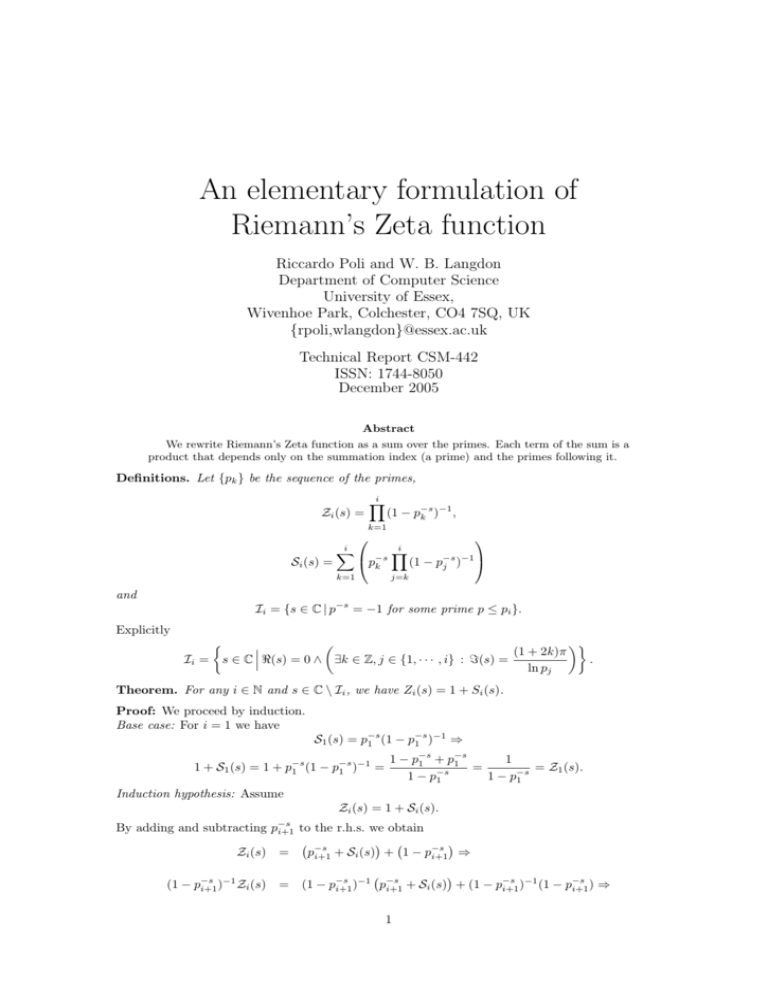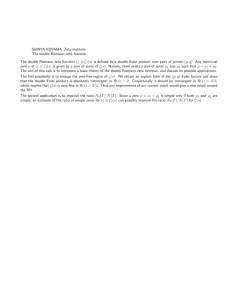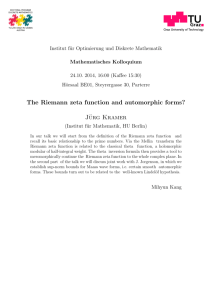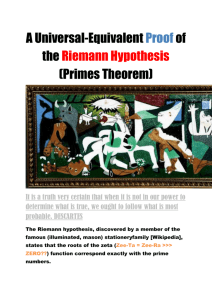An elementary formulation of Riemann`s Zeta function
advertisement

An elementary formulation of
Riemann’s Zeta function
Riccardo Poli and W. B. Langdon
Department of Computer Science
University of Essex,
Wivenhoe Park, Colchester, CO4 7SQ, UK
{rpoli,wlangdon}@essex.ac.uk
Technical Report CSM-442
ISSN: 1744-8050
December 2005
Abstract
We rewrite Riemann’s Zeta function as a sum over the primes. Each term of the sum is a
product that depends only on the summation index (a prime) and the primes following it.
Definitions. Let {pk } be the sequence of the primes,
i
Y
Zi (s) =
−1
(1 − p−s
,
k )
k=1
Si (s) =
i
X
p−s
k
k=1
i
Y
−1
(1 − p−s
j )
j=k
and
Ii = {s ∈ C | p−s = −1 for some prime p ≤ pi }.
Explicitly
(1 + 2k)π
Ii = s ∈ C <(s) = 0 ∧ ∃k ∈ Z, j ∈ {1, · · · , i} : =(s) =
.
ln pj
Theorem. For any i ∈ N and s ∈ C \ Ii , we have Zi (s) = 1 + Si (s).
Proof: We proceed by induction.
Base case: For i = 1 we have
−s −1
S1 (s) = p−s
⇒
1 (1 − p1 )
−s −1
1 + S1 (s) = 1 + p−s
=
1 (1 − p1 )
−s
1 − p−s
1
1 + p1
=
= Z1 (s).
−s
1 − p1
1 − p−s
1
Induction hypothesis: Assume
Zi (s) = 1 + Si (s).
By adding and subtracting
Zi (s)
−1
(1 − p−s
Zi (s)
i+1 )
p−s
i+1
to the r.h.s. we obtain
−s
= p−s
i+1 + Si (s) + 1 − pi+1 ⇒
=
−s −1
−1
(1 − p−s
p−s
(1 − p−s
i+1 )
i+1 + Si (s) + (1 − pi+1 )
i+1 ) ⇒
1
Zi+1 (s)
=
−1 −s
(1 − p−s
pi+1 +
i+1 )
i
X
p−s
k
k=1
=
−1 −s
(1 − p−s
pi+1 +
i+1 )
i
X
p−s
k
k=1
=
i+1
X
k=1
p−s
k
i+1
Y
i
Y
−1
(1 − p−s
+1
j )
j=k
i+1
Y
−1
(1 − p−s
+1
j )
j=k
−1
(1 − p−s
+1⇒
j )
j=k
Zi+1 (s) = 1 + Si+1 (s).
2
Corollary. For <(s) > 1, Riemann’s Zeta function can be written as
ζ(s) = 1 +
∞
X
ak (s)p−s
k
k=1
where ak (s) =
∞
Y
−1
(1 − p−s
.
j )
j=k
Proof: The result follows directly from noting that Euler’s product formula can be expressed as
ζ(s) = lim Zi
i→∞
2
and from the previous theorem.
In this formulation, the Riemann’s Zeta function is expressed as a sum over the primes, where
each term is a product with factors depending only on the summation index (a prime) and the
primes following it. The formulation is interesting also because of its similarity with the original
∞
X
n−s , the factors ak (s) effectively being corrections that
definition of the Zeta function, ζ(s) =
n=1
account for all the (non-prime) naturals whose prime factor decomposition starts with pk .
Acknowledgements
The authors would like to thank John Ford and Ray Turner for helpful discussions.
2











